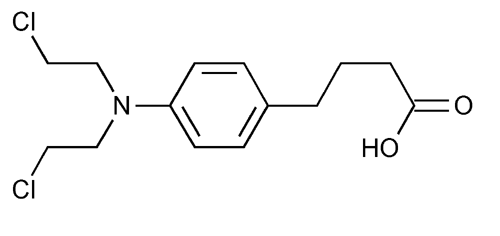Chlorambucil
Benzenebutanoic acid, 4-[bis(2-chloroethyl)amino]-.
4-[p-[Bis(2-chloroethyl)amino]phenyl]butyric acid
» Chlorambucil contains not less than 98.0 percent and not more than 101.0 percent of C14H19Cl2NO2, calculated on the anhydrous basis.
Caution—Great care should be taken to prevent inhaling particles of Chlorambucil and exposing the skin to it.
Packaging and storage—
Preserve in tight, light-resistant containers.
Identification—
A:
Infrared Absorption  197S
197S : 1 in 125 solution, carbon disulfide, 1-mm cell.
: 1 in 125 solution, carbon disulfide, 1-mm cell.
B:
Dissolve 50 mg in 5 mL of acetone, and dilute with water to 10 mL. Add 1 drop of 2 N sulfuric acid, then add 4 drops of silver nitrate TS: no opalescence is observed immediately (absence of chloride ion). Warm the solution on a steam bath: opalescence develops (presence of ionizable chlorine).
Water, Method I  921
921 :
not more than 0.5%.
:
not more than 0.5%.
Assay—
Dissolve about 200 mg of Chlorambucil, accurately weighed, in 10 mL of acetone, add 10 mL of water, and titrate with 0.1 N sodium hydroxide VS, using phenolphthalein TS as the indicator. Each mL of 0.1 N sodium hydroxide is equivalent to 30.42 mg of C14H19Cl2NO2.
Auxiliary Information—
Please check for your question in the FAQs before contacting USP.
Chromatographic Column—
| Topic/Question | Contact | Expert Committee |
| Monograph | Feiwen Mao, M.S.
Scientist 1-301-816-8320 |
(MDOOD05) Monograph Development-Ophthalmics Oncologics and Dermatologicals |
| Reference Standards | Lili Wang, Technical Services Scientist 1-301-816-8129 RSTech@usp.org |
USP32–NF27 Page 1884
Chromatographic columns text is not derived from, and not part of, USP 32 or NF 27.
